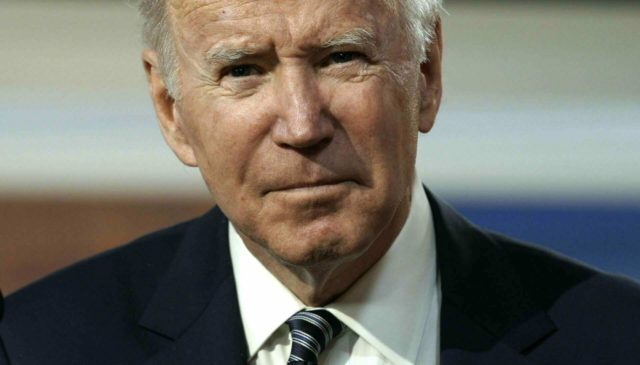
Biden warns threat of Russian invasion of Ukraine ‘very high’ as Russia expels No. 2 diplomat President Joe Biden. (Yuri Gripas/Abaca Press/TNS)
This article was originally published by Radio Free Europe/Radio Liberty and is reprinted with permission.
U.S. President Joe Biden says the threat of a Russian invasion of Ukraine is “very high” but that the door to a diplomatic solution remains open, even after Russia expelled the No. 2 official from the U.S. Embassy in Moscow.
Biden told reporters on February 17 as he departed the White House that he had received Russia’s response to U.S. security proposals but could not comment because he had not yet read it.
Asked to assess the threat level, Biden said: “My sense is this [attack] will happen in the next several days.”
Biden said Russia has not moved back its forces from the Ukrainian border as Moscow has claimed and said the United States has reason to believe Russia is engaged in a “false-flag operation” to justify an invasion.
“Every indication we have is they’re prepared to go into Ukraine and attack Ukraine,” Biden added.
A spokesman for the U.S. Embassy confirmed the expulsion of Bart Gorman, the deputy chief of mission at the embassy in Moscow but gave no details on why the move was taken.
“Russia’s action against our DCM was unprovoked and we consider this an escalatory step and are considering our response,” a spokesperson for the U.S. State Department said.
Secretary of State Antony Blinken told the UN Security Council that Russia is “taking steps down the path to war” and that the only responsible way to resolve the crisis over its troop buildup near Ukraine is diplomacy.
The U.S. chief diplomat warned that Russian forces are preparing to launch an attack against Ukraine in “coming days,” and it likely would be preceded by fake or real attacks that would give it a pretext to invade. He said the targets include the capital, Kyiv, a city of 2.8 million people.
Blinken said he wanted to speak to the council “not to start a war but to prevent one.” He urged Russia to “choose a different path” and avert a war that would affect the lives and safety of millions of people.
“The Russian government can announce today, with no qualification, equivocation, or deflection, that Russia will not invade Ukraine. State it clearly. State it plainly to the world, and then demonstrate it by sending your troops, your tanks, the planes back to their barracks and hangars and sending your diplomats to the negotiating table,” Blinken said, speaking to the 15-member council in New York.
He also said he has asked for another in-person meeting with Russian Foreign Minister Sergei Lavrov to take place next week in Europe and said Germany and France are standing by ready to take up negotiations on the conflict in eastern Ukraine following the Minsk accords.
If Russia wants diplomacy the United States and its allies “will give Moscow every opportunity for it to demonstrate that commitment,” Blinken said.
Russian Deputy Foreign Minister Sergei Vershinin told the council the military scenarios put forward by Blinken were regrettable and dangerous and said some Russian soldiers are returning to their home bases.
The United States and NATO earlier this week dismissed Russia’s claims of a troop withdrawal and said Moscow was in fact sending more forces to areas near Ukraine.
Biden spoke after Ukraine and Russia-backed separatists in the east traded accusations of shelling across the cease-fire line, with President Volodymyr Zelenskiy accusing the separatist forces of shelling a kindergarten.
NATO Secretary-General Jens Stoltenberg told reporters after a two-day meeting of the alliance’s defense ministers in Brussels on February 17 that the Russians “have enough troops, enough capabilities to launch a full-fledged invasion of Ukraine with very little or no warning time.”
“That is what makes the situation so dangerous,” Stoltenberg added.
The Ukrainian military’s command center in the east said separatists had, “with special cynicism,” fired heavy artillery at a village in the area controlled by Kyiv and “the shells hit a kindergarten,” wounding two civilians.
Zelenskiy said the shelling of the kindergarten was a “big provocation,” while British Prime Minister Boris Johnson called it a “false-flag” operation.
“A kindergarten was shelled in what we…know was a false-flag operation designed to discredit the Ukrainians, designed to create a pretext, a spurious provocation for Russian action,” Johnson told British media.
Separatist authorities in the Luhansk region, in turn, claimed the Ukrainian side was shelling across the line of contact, describing it as a “large-scale provocation.”
Ukraine has been fighting separatists in the east since April 2014 in a conflict that has cost at least 13,200 lives.
British Foreign Secretary Liz Truss on February 17 warned that Russia was seeking to fabricate a pretext to invade Ukraine after Moscow said it was “concerned” about the shelling.
“Reports of alleged abnormal military activity by Ukraine in Donbas are a blatant attempt by the Russian government to fabricate pretexts for invasion. This is straight out of the Kremlin playbook,” Truss said on Twitter, adding that Britain would “continue to call out Russia’s disinformation campaign.”
NATO and several Western governments have said that Russia is continuing to beef up its military presence near the border with Ukraine despite Moscow’s “false” claims that it had started to withdraw troops from the area as frantic diplomatic efforts continue amid fears that Russia is about to invade its neighbor.
Russian officials said the pullback continued on February 17, but those claims appeared to be rebutted by satellite images from Maxar Technologies, a private U.S. company that has been tracking the buildup of Russian forces for weeks, which showed military equipment arriving even as some deployed near Ukraine’s border had been moved. The images show the building of a pontoon bridge in Belarus less than 6 kilometers from the Ukrainian border.
“We have seen the opposite of some of the statements [from Moscow]. We have seen an increase of troops over the last 48 hours, up to 7,000,” British Defense Secretary Ben Wallace said ahead of a meeting of NATO defense ministers in Brussels.
Wallace’s comments were echoed by EU Commission chief Ursula von der Leyen, who said on February 17 that “we hear claims from Russia about pulling back troops but we have not seen any sign of de-escalation on the ground.”
“To the contrary, the buildup continues,” she told reporters in Brussels ahead of an extraordinary EU summit set to discuss the crisis.
Russia is using the troop buildup to coerce the United States and NATO into agreeing to sweeping security demands, including a ban on Ukraine’s membership in the Western alliance and a rollback of NATO’s advances in Central and Eastern Europe since the collapse of the Soviet Union.
The state TASS news agency quoted Russia’s Foreign Ministry as saying the responses delivered to the United States offer a chance for Washington to cooperate to develop a new “security equation” for Europe. It did not give any further details.
In Washington, a senior White House official slammed Moscow’s announcement of a withdrawal as “false,” telling journalists that Russia had increased its presence on the border with Ukraine by “as many as 7,000 troops,” some of whom arrived on February 16.
The official, who requested anonymity, also warned that Russia could use “a false pretext” to attack Ukraine.
“We continue to receive indications they could launch a false pretext at any moment to justify an invasion.” The official added that while Moscow had said it wants to reach a diplomatic solution, its actions “indicate otherwise.”
Separately, State Department spokesman Ned Price said, “This is the Russian playbook, to paint a picture publicly…while they do the opposite.”
As the West continued to question the veracity of Moscow’s statements, Russia on February 17 announced a new drawdown of military forces from the occupied Crimean Peninsula.
“Units of the southern military district that ended tactical exercises at training grounds on the Crimean peninsula are returning by rail to their permanent bases,” the Defense Ministry said in a statement carried by Russian news agencies.
State-run television showed columns of military hardware crossing a recently-constructed bridge connecting the peninsula to the Russian mainland.
Ahead of a visit to Kyiv on February 17, Truss also warned that Putin could drag out the Ukraine crisis for months in an attempt to challenge Western unity.
“There is currently no evidence the Russians are withdrawing from border regions near Ukraine,” Truss wrote in The Daily Telegraph newspaper. “The Russian military buildup shows no signs of slowing.”
“We must have no illusions that Russia could drag this out much longer in a brazen ploy to spend weeks more — if not months — subverting Ukraine and challenging Western unity,” wrote Truss, who is due in Ukraine on February 17.
German Chancellor Olaf Scholz also said on February 16 that “the risk of a further military aggression by Russia” remains “high,” according to a statement issued following a phone call with U.S. President Joe Biden. Scholz met with Putin in the Kremlin earlier in the week.
The Kremlin has rejected it has any plan to invade Ukraine, calling the Western warnings hysterical war propaganda.




